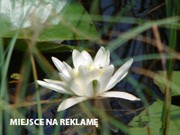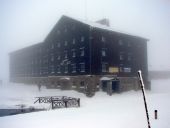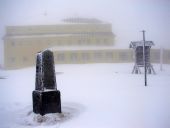"Życie to krótki sen, którego sentymentalnie ja się nie wstydzę..." //z piosenki Stanisława Sojki//

Start
Tourist's routes
Photos
Useful information
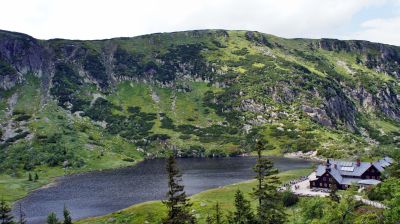
Karkonosze (also called Giant Mountains) are the highest and largest mountain chain in Sudetes mountain system. Located in the south - western Poland on the border with the Czech Republic. Karkonosze area is approximately 650 km2 of which over 2/3 is located on the Czech Republic side. But the highest peak Śnieżka (1602 m. above sea-level ) and many attractions such as Śnieżne Kotły (glacial cirques called: Snow boilers), most interesting rock formations, waterfalls are located in the Polish part of Karkonosze. The entire Sudetes mountain system, thus also Karkonosze are the oldest mountains in Poland. Formation of the Sudetes has started in the Precambrian era about 650 million years ago. Currently, the entire main ridge of the Karkonosze is subject to strict protection. In 1933 nature reserves were established. They included glacial cirques: Śnieżne Kotły (Snow Boilers), Kocioł Małego Stawu (Little Pond Boiler), Kocioł Małego Stawu (Great Pond Boiler). The Karkonosze National Park was established in 1959. Karkonosze has probably the best developed and extensive network of shelters in comparison to other mountain ranges in Poland. This is caused by the fact that over the main ridge runs the state border, so Poland has a lot of shelters on its side and the Czech Republic as well. I counted 16 shelters on the main, red marked trail, (within half an hour away from the trail in both directions) from the Szrenicka alp to Okraj pass.
A curiosity encounter at the main trail are imaginative state border posts. Small gallery with state border posts below:
 |
 |
 |
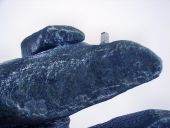 |
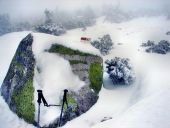 |
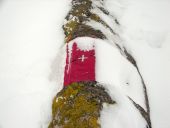 |
Suggested 3 days route:
1st day: Shelter Kochanówka - The Old Walloon Cottage - Szklarska Poreba - Kamieńczyk hostel - Szrenicka alp - Szrenica hostel - hostel: "Pod Łabskim Szczytem" (under Labski peak)
duration: about 5 hours. (not including stay in The Old Walloon Cottage and Szklarska Poręba town) however, I advise to start at approx. 9 a.m., because there is a lot of attractions and shelters on the trail and in practice the proposed route takes approximately 8 - 9 hrs.
difficulty: quite easy
Kochanówka hostel is located about 10 minutes from road: Jelenia Góra - Szklarska Poręba.
From the main road You should follow black marked trail.
You can take a bus from Jelenia Góra - journey takes about 40 minutes.
Next to the bus stop is also a parking.
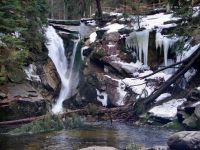 Kochanówka hostel was founded in 1868 - originally functioned as a pub, called Kochellfalbaude.
Near the hostel is located waterfall Szklarka - 13 meters high.
Such environment makes that spending night in Kochanówka is very attractive and somewhat romantic.
Our trail starts at the waterfall and is black marked (paralel to the black trail there is also blue trail, which is quite
boring and leads directly to the hostel under Łabski peak, but we have to follow the black marked trail).
Kochanówka hostel was founded in 1868 - originally functioned as a pub, called Kochellfalbaude.
Near the hostel is located waterfall Szklarka - 13 meters high.
Such environment makes that spending night in Kochanówka is very attractive and somewhat romantic.
Our trail starts at the waterfall and is black marked (paralel to the black trail there is also blue trail, which is quite
boring and leads directly to the hostel under Łabski peak, but we have to follow the black marked trail).
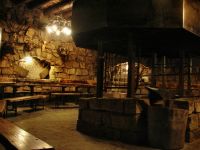 The first stage of hiking leads through forest along Szklarka stream.
After about 20 minutes, we go out into the open space, there are the first buildings.
We have to look for carefully signs to Old Walloon Cottage (Stara Chata Walońska).
Old Walloon Cottage is placed on the right side of our trail, but it is quite
inconspicuous and easy to miss.
Old Walloon Cottage is worth a visit, because there is
lot of attractions: the opportunity to visit the underworld - numerous original exhibits as skeletons,
animal antlers, a collection of beer and wine bottles from the communist era, with interesting names;
collection of rocks and minerals found in Karkonosze; the possibility of self- making the personal
Walloon amulet.
The first stage of hiking leads through forest along Szklarka stream.
After about 20 minutes, we go out into the open space, there are the first buildings.
We have to look for carefully signs to Old Walloon Cottage (Stara Chata Walońska).
Old Walloon Cottage is placed on the right side of our trail, but it is quite
inconspicuous and easy to miss.
Old Walloon Cottage is worth a visit, because there is
lot of attractions: the opportunity to visit the underworld - numerous original exhibits as skeletons,
animal antlers, a collection of beer and wine bottles from the communist era, with interesting names;
collection of rocks and minerals found in Karkonosze; the possibility of self- making the personal
Walloon amulet.
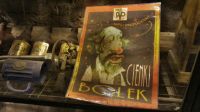 The entry is free of charge, more information at: www.chatawalonska.pl.
We go back to our black marked trail - from here is about 30 minutes to the center of Szklarska Poręba town.
There are many restourants in the town, so You can eat and drink something.
After the rest You have to find the main road and turn left
(it takes 10 - 20 minutes) into Jakuszyce direction, untill the entry to the red marked
trail.
The entry is free of charge, more information at: www.chatawalonska.pl.
We go back to our black marked trail - from here is about 30 minutes to the center of Szklarska Poręba town.
There are many restourants in the town, so You can eat and drink something.
After the rest You have to find the main road and turn left
(it takes 10 - 20 minutes) into Jakuszyce direction, untill the entry to the red marked
trail.
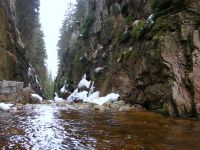 This trail will take You to Kamieńczyk hostel within about 40 minutes.
The route leads along the gorge, at the bottom flows stream called Kamieńczyk.
Along the way, near the shelter is a descent into the gorge and waterfall.
The descent is paid and helmets are mandatory.
In 1973, here was an accident, a stone hit and kill the tourist, after that, descent to the waterfall
was closed for many years.
At the Kamieńczyk hostel You can relax, there's a viewing platform - You can admire Karkonosze
mountains and Kamieńczyk waterfall.
This trail will take You to Kamieńczyk hostel within about 40 minutes.
The route leads along the gorge, at the bottom flows stream called Kamieńczyk.
Along the way, near the shelter is a descent into the gorge and waterfall.
The descent is paid and helmets are mandatory.
In 1973, here was an accident, a stone hit and kill the tourist, after that, descent to the waterfall
was closed for many years.
At the Kamieńczyk hostel You can relax, there's a viewing platform - You can admire Karkonosze
mountains and Kamieńczyk waterfall.
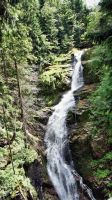 After the rest and taking a photo You have to hike further along the red trail.
After a few minutes You will reach the cash point - where
you have to buy an entry ticket to the Karkonosze National Park.
For about 45 minutes we hike on pavement following the red trail
(however path is very wide and there is no way to get lost)
to the next point - Szrenicka Alp.
There is a hostel with a powerful silhouette, offering 110 beds.
From here is close to the next hostel - Szrenica. From the alp You have to still follow the red trail
- after about 20 minutes there is a crossroads, here we can see black marked trail which turns
left - this black trail will take You to hostel Szrenica (within 5 minutes). Of course, if You don't need
a rest, You can not turn the left and follow red marked trail.
The entry to the peak Szrenica (1362 meters above sea level) is not allowed. This area is under
strict protection.
After the rest and taking a photo You have to hike further along the red trail.
After a few minutes You will reach the cash point - where
you have to buy an entry ticket to the Karkonosze National Park.
For about 45 minutes we hike on pavement following the red trail
(however path is very wide and there is no way to get lost)
to the next point - Szrenicka Alp.
There is a hostel with a powerful silhouette, offering 110 beds.
From here is close to the next hostel - Szrenica. From the alp You have to still follow the red trail
- after about 20 minutes there is a crossroads, here we can see black marked trail which turns
left - this black trail will take You to hostel Szrenica (within 5 minutes). Of course, if You don't need
a rest, You can not turn the left and follow red marked trail.
The entry to the peak Szrenica (1362 meters above sea level) is not allowed. This area is under
strict protection.
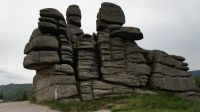 After the rest in hostel You have to go back to the
crossroads and continue following red trail.
A few minutes later You will pass the rock formations called the Three Little Pigs,
the next few minutes You will come to the rock called Twarożnik - here is also the yellow trail
which leads (several minutes) to hostel Vosecka Bouda in Czech Republic.
The Czech hostels generally are not similar to our Polish.
Usually you can not eat your own food there.
In Vosecká Bouda we were serviced by the waiter, and a beer cost 10 zł (in 2011).
If you decided to visit Vosecka Bouda, you have two options: go back to red trail and go to the right,
following red trail, or go the green marked Czech trail (it's important to go to the left, not straight)
which will take You to the yellow trail, then You have to turn the left on this yellow trail.
After the rest in hostel You have to go back to the
crossroads and continue following red trail.
A few minutes later You will pass the rock formations called the Three Little Pigs,
the next few minutes You will come to the rock called Twarożnik - here is also the yellow trail
which leads (several minutes) to hostel Vosecka Bouda in Czech Republic.
The Czech hostels generally are not similar to our Polish.
Usually you can not eat your own food there.
In Vosecká Bouda we were serviced by the waiter, and a beer cost 10 zł (in 2011).
If you decided to visit Vosecka Bouda, you have two options: go back to red trail and go to the right,
following red trail, or go the green marked Czech trail (it's important to go to the left, not straight)
which will take You to the yellow trail, then You have to turn the left on this yellow trail.
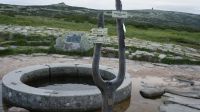 Both variants take the similar time - 1 hour.
However, the green and yellow option is more interesting, because we
pass on the way the source of the Elbe (Labe Pramen).
When you will reach again the red trail, go straight to the hostel under Łabski Peak (Elbe Peak),
there is no trail, but there is a path, called the "wet path".
This path will lead You, after several minutes to yellow trail - this part of trail (from crossroads red and yello)
takes about 30 minutes.
Both variants take the similar time - 1 hour.
However, the green and yellow option is more interesting, because we
pass on the way the source of the Elbe (Labe Pramen).
When you will reach again the red trail, go straight to the hostel under Łabski Peak (Elbe Peak),
there is no trail, but there is a path, called the "wet path".
This path will lead You, after several minutes to yellow trail - this part of trail (from crossroads red and yello)
takes about 30 minutes.
Below photos of hostels met on the way. From left side: Kochanówka, Kamieńczyk, Szrenicka alp, Szrenica hostel, Vosecka bouda, hostel under Łabski Peak:
 |
 |
 |
 |
 |
 |
2nd day: hostel under Łabski Peak - Łabski Peak - glacial cirque: Śnieżne Kotły (Snow Boilers) - Karkonoska Pass - hostel Odrodzenie (means: Rebirth) - Sunflower rock - hostel Strzecha Akademicka
duration: about 6 hours
difficulty: quite easy
The route starts near the hostel under Łabski Peak - You have to follow yellow marked trail.
For about 1 hour we hike on the convenient path, trail leads on the slopes of Łabski Peak
in the direction of Radio - Television relay station and glacial cirque Śnieżne Kotły.
The trail leads up the hill, but the climb is gentle.
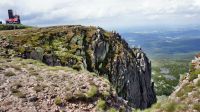 The area is open, so you can admire views and take pictures.
This climb and further parts of the route (especially when
traversing the Wielki Szyszak Peak) is a bit like in Low Tatras - Chopok region.
TV relay station does not have accomodation, there is no buffet,
but in extreme circumstances when is a risk of life, the station is obliged to take tourists to stay.
It is interesting, that in 1837 there was
a small hostel (founded by the owner of this area - Count Schaffgotsch), which
only in 1961 was taken over by Radio - Television relay station.
The area is open, so you can admire views and take pictures.
This climb and further parts of the route (especially when
traversing the Wielki Szyszak Peak) is a bit like in Low Tatras - Chopok region.
TV relay station does not have accomodation, there is no buffet,
but in extreme circumstances when is a risk of life, the station is obliged to take tourists to stay.
It is interesting, that in 1837 there was
a small hostel (founded by the owner of this area - Count Schaffgotsch), which
only in 1961 was taken over by Radio - Television relay station.
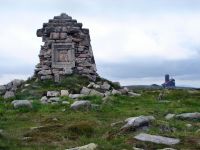 Glacial cirques: Mały i Wielki Śnieżny Kocioł (Small and Great Snow Boiler)
are one of the biggest attractions in Karkonosze.
I would say, these glaciers are the characteristic "souvenir" from ice age .
The walls are over 200 meters high and at the bottom there are
Śnieżne Stawki (Snow ponds). The described glacial cirques area is under strict protection.
After admire of beautiful views, You have to continue along the red marked trail.
You have to traverse Wielki Szyszak Peak (1509 meters AMSL) - the second
highest peak in Karkonosze.
If anyone wants, you can climb to the top - at the beginning of the trail, just after
glaciers, you have to look for informal path turning right.
Glacial cirques: Mały i Wielki Śnieżny Kocioł (Small and Great Snow Boiler)
are one of the biggest attractions in Karkonosze.
I would say, these glaciers are the characteristic "souvenir" from ice age .
The walls are over 200 meters high and at the bottom there are
Śnieżne Stawki (Snow ponds). The described glacial cirques area is under strict protection.
After admire of beautiful views, You have to continue along the red marked trail.
You have to traverse Wielki Szyszak Peak (1509 meters AMSL) - the second
highest peak in Karkonosze.
If anyone wants, you can climb to the top - at the beginning of the trail, just after
glaciers, you have to look for informal path turning right.
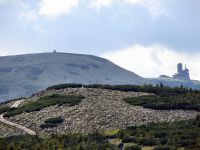 At the top there is a monument to commemorate the reign of Emperor Wilhelm I .
The return is along the same path back to the red marked trail.
We walk the red trail on the main ridge of Karkonosze (on the way we pass numerous rock formations:
Czech Stones and Silesia Stones, in the Czech language called: men's and women's stones)
for about 1.30 hours to the point where the asphalt begins.
There is a closed (in 2011) Petrova bouda shelter.
All the time we have to follow red trail which leads along the said road.
After half an hour You will come to Karkonoska Pass.
At the top there is a monument to commemorate the reign of Emperor Wilhelm I .
The return is along the same path back to the red marked trail.
We walk the red trail on the main ridge of Karkonosze (on the way we pass numerous rock formations:
Czech Stones and Silesia Stones, in the Czech language called: men's and women's stones)
for about 1.30 hours to the point where the asphalt begins.
There is a closed (in 2011) Petrova bouda shelter.
All the time we have to follow red trail which leads along the said road.
After half an hour You will come to Karkonoska Pass.
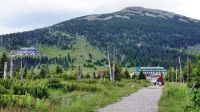 On the pass are three buildings: the former military outpost - now
4 star Czech hotel "Depandance", the luxury Czech hotel Spindlerova bouda
(up to 2006 it was a hostel, and now it is the object with a swimming pool, sauna, where accommodation costs about EUR 35 in low season)
as well as Polish hostel Odrodzenie ( the name means 'Revival'), one of the largest shelters on the Polish side of Karkonosze
- offering 112 beds).
On the pass are three buildings: the former military outpost - now
4 star Czech hotel "Depandance", the luxury Czech hotel Spindlerova bouda
(up to 2006 it was a hostel, and now it is the object with a swimming pool, sauna, where accommodation costs about EUR 35 in low season)
as well as Polish hostel Odrodzenie ( the name means 'Revival'), one of the largest shelters on the Polish side of Karkonosze
- offering 112 beds).
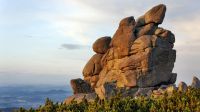 After a rest and a meal in hostel, You have to
continue trip along the red trail.
After over an hour we get to the characteristic
point - the rock called Sunflower (It is interesting that near Sunflower
there was a large shelter, called Prince Henry shelter, unfortunately, burned down in 1947).
Here starts the yellow trail - if you have enough power and more than hour of free time, You can
go down following the yellow trail to watch a group of rock formations called Pilgrims and return back to the red trail.
Next part of our route takes about half an hour from Sunflower rock, You have to follow
the red marked trail.
After a rest and a meal in hostel, You have to
continue trip along the red trail.
After over an hour we get to the characteristic
point - the rock called Sunflower (It is interesting that near Sunflower
there was a large shelter, called Prince Henry shelter, unfortunately, burned down in 1947).
Here starts the yellow trail - if you have enough power and more than hour of free time, You can
go down following the yellow trail to watch a group of rock formations called Pilgrims and return back to the red trail.
Next part of our route takes about half an hour from Sunflower rock, You have to follow
the red marked trail.
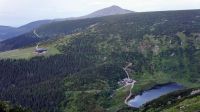 This part is wonderful, as we walk along the ridge,
on the left side, down, we can see Big and Little Lake and hostel Samotnia (means Solitude).
When you will reach the blue trail - turn left and follow this blue trail - it takes
about 20 minutes to the Strzecha Akademicka hostel.
This part is wonderful, as we walk along the ridge,
on the left side, down, we can see Big and Little Lake and hostel Samotnia (means Solitude).
When you will reach the blue trail - turn left and follow this blue trail - it takes
about 20 minutes to the Strzecha Akademicka hostel.
3rd day: Strzecha Akademicka hostel - hostel Samotnia (Solitude) - Hunting house - The Temple of Wang - Karpacz town - Jelenia Gora town
duration: about 1.45 hours to Wang Temple in Karpacz
difficulty: easy
The planned route is short - because we go back home
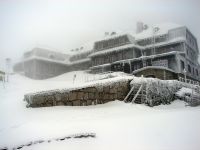 (you can continue the trip and climb on
Śnieżka (1602 AMSL) - the highest peak of Karkonosze - about 1.30 hour climg from Strzecha Akademicka shelter).
From Strzecha hostel we go along the blue marked route for about 20 min
to the Samotnia hostel.
It is one of the most beautiful hostels located in Poland.
(you can continue the trip and climb on
Śnieżka (1602 AMSL) - the highest peak of Karkonosze - about 1.30 hour climg from Strzecha Akademicka shelter).
From Strzecha hostel we go along the blue marked route for about 20 min
to the Samotnia hostel.
It is one of the most beautiful hostels located in Poland.
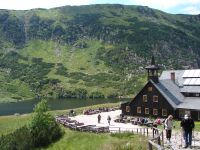 The walls are up to 200 meters height above the mirror pond,
numerous avalanches come down in winter time, so that winter night in this hostel,
when avalanches are falling with a vengeance on the icy surface of Little Pond, can be an unique experiance.
In spring and summer you can sit at the tables, close to the pond.
The walls are up to 200 meters height above the mirror pond,
numerous avalanches come down in winter time, so that winter night in this hostel,
when avalanches are falling with a vengeance on the icy surface of Little Pond, can be an unique experiance.
In spring and summer you can sit at the tables, close to the pond.
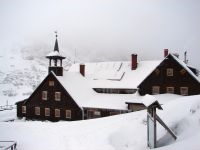 Prices in Samotnia are relatively high.
After the rest, enjoying the views You have to follow further the blue route, partially on banks of a Small Pond.
Along the way, you can see Hunter's House - it belongs to Karkonosze National Park.
Prices in Samotnia are relatively high.
After the rest, enjoying the views You have to follow further the blue route, partially on banks of a Small Pond.
Along the way, you can see Hunter's House - it belongs to Karkonosze National Park.
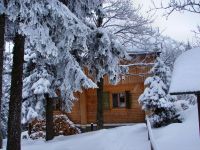 After about 40 minutes You will reach the cross with the yellow trail (yellow trail goes to the left - 25 min. to the rocks Pilgrims).
This place is called Polana - Glade (in the past here was a large shelter), there are benches and tables, so with
own lunch, you can arrange the camp.
After about 40 minutes You will reach the cross with the yellow trail (yellow trail goes to the left - 25 min. to the rocks Pilgrims).
This place is called Polana - Glade (in the past here was a large shelter), there are benches and tables, so with
own lunch, you can arrange the camp.
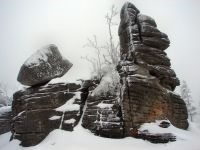 We go slightly to the right, following blue marked route, after about 35 minutes we get to the temple Wang.
We go slightly to the right, following blue marked route, after about 35 minutes we get to the temple Wang.
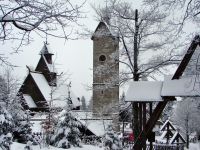 Interestingly, the temple Wang comes
from the twelfth-thirteenth century and was built in Norway. In the nineteenth century, was purchased by
King of Prussia - Frederick William IV and transported to Karpacz.
Interestingly, the temple Wang comes
from the twelfth-thirteenth century and was built in Norway. In the nineteenth century, was purchased by
King of Prussia - Frederick William IV and transported to Karpacz.
Photogalleries of Karkonosze
(click on below photos to go to galleries)
Karkonosze photo gallery - part 1 - summer
Kochanówka hostel - Old Walloon Cottage - Kamieńczyk hostel - Szrenicka alp -
Szrenica hostel - under Łabski Peak hostel - Łabski Peak - Śnieżne Kotły - Karkonoska Pass –
Odrodzenie hostel - Sunflower rock - Strzecha Akademicka hostel - Samotnia hostel – Wang temple - Jelenia Góra
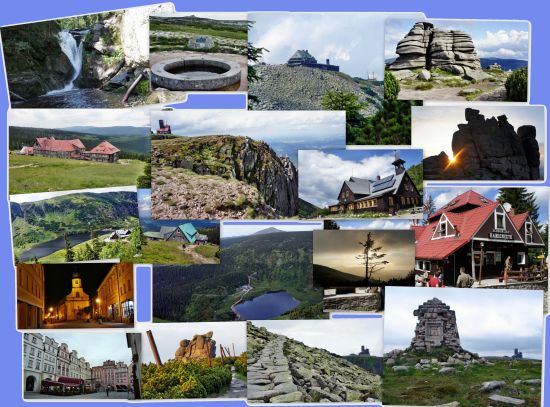
Karkonosze photo gallery - part 2 - winter
Kochanówka hostel - Old Walloon Cottage - Kamieńczyk hostel -
Szrenicka alp - Szrenica - under Łabski Peak hostel - Labska luka - pramen Labe - RTV station - Petrowa bouda –
Odrodzenie hostel - Sunflower rock - Lucni bouda - "Śląski Dom" hostel under Śnieżka - Strzecha Akademicka hostel - Samotnia hostel -
Rocks Pilgrims – Wang temple - Jelenia Góra

Approach:
The main transport hub in Karkonosze is Jelenia Gora town. Buses and trains from various places in Poland run here. Jelenia Gora has a good connection to bigger city - Wroclaw. From Wroclaw to Jelenia are some buses a day. From Jelenia Gora You can easily get a bus to the mountain towns: Szklarska Poreba and Karpacz. If You have a few hours of free time, e.g. waiting for a bus, You can take a walk in the Jelenia Gora. It is one of the largest cities in the Lower Silesia region (Dolny Śląsk), the traffic is routed edging, so the city center is very calm and walkers friendly. From the railway station and bus station to the old market, there is about 15 minutes walk.
A photo gallery from Jelenia Gora:
 |
 |
 |
 |
 |
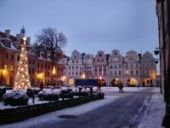 |
Accomodation:
Szklarska Poreba and Karpacz as a typical tourist towns have a well developed accommodation base. Many little hotels, guesthouses and private accommodation offer something for everyone. I don't recommend anything, because we did not use the accommodation in these destinations, we slept in mountain chalets. An interesting alternative (depending on your time and approach routes) is an accomodation in Michałowice and in the ruins of Chojnik Castle.
Below photos of hostels where we slept, ate and drank: